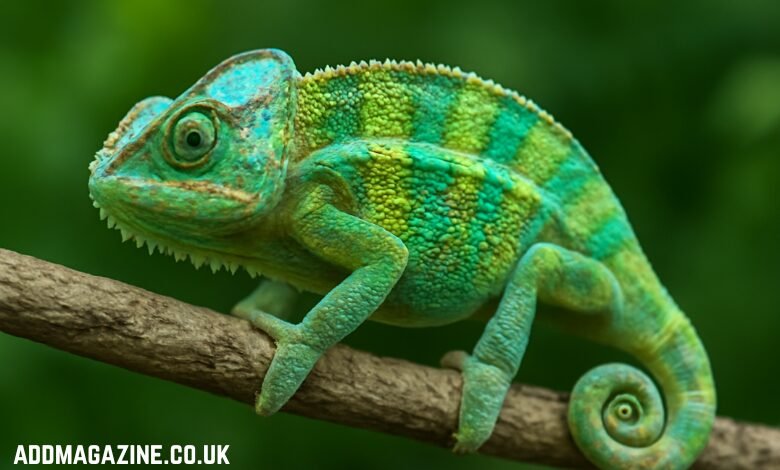Chameleons, or Chameleónovité as referred to in Slovak, are a family of lizards known for their unique characteristics and fascinating adaptations. The family Chamaeleonidae encompasses over 200 species, primarily native to Africa, Madagascar, and parts of Asia and Europe. These lizards have become iconic for their ability to change color, their specialized feet, and their long, sticky tongues. Despite their recognition, there is much more to chameleons than their color-changing abilities. This article will explore the biology, behavior, and ecology of chameleons, shedding light on what makes them so unique.
1. An Overview of Chameleons
Chameleons belong to the Chamaeleonidae family, a group of Old World lizards. They are predominantly found in regions with warm climates, such as sub-Saharan Africa, the Mediterranean, the Arabian Peninsula, and parts of Asia. The largest concentration of chameleon species is found in Madagascar, where the diversity of the group is the highest.
These reptiles are generally small to medium-sized, with some species reaching lengths of up to 24 inches (60 cm), though many are much smaller. They have a relatively slow metabolism, which contributes to their need for a warm environment.
Chameleons are highly adaptable and specialized creatures, designed to thrive in various habitats ranging from tropical forests to arid desert landscapes. The most striking feature of chameleons is their color-changing ability, a characteristic that has earned them a great deal of attention. However, this ability serves several purposes beyond what most people initially assume.
2. Physical Characteristics
Color Changing Ability
One of the most famous characteristics of chameleons is their ability to change color. This ability is often misunderstood as being linked to camouflage or hiding from predators. While it does help with camouflage in some species, the primary reason for color change is communication. Chameleons use different colors and patterns to signal aggression, dominance, mating readiness, and even stress levels. For instance, a male might display vibrant colors to attract a mate, while a stressed chameleon might darken its skin.
The mechanism behind this color change is complex. Chameleons have special pigment cells called chromatophores, which contain different pigments. Beneath these cells, they also have iridophores or guanophores, which are cells that reflect light. The interaction between these cells allows chameleons to produce a range of colors, from greens and blues to reds and yellows.
Eyes and Vision
Chameleons are known for their distinctive eyes, which can move independently of each other. This allows them to scan their surroundings for both predators and prey without having to move their bodies. Chameleons have excellent vision, with some species capable of seeing in ultraviolet light, something that is unusual among vertebrates.
The eyes of a chameleon are also capable of focusing in a unique way. They can focus on objects at different distances simultaneously, which is essential for their feeding strategy. Their eyes are positioned in such a way that they can judge the distance of an object with great accuracy, aiding them in capturing prey with their long tongues.
Tongue and Feeding
Chameleons have a long, sticky tongue that can extend to more than twice the length of their body. This remarkable adaptation allows them to catch prey from a considerable distance. The tongue is controlled by powerful muscles and is capable of reaching out with impressive speed and accuracy. Once the tongue makes contact with the prey, it adheres to the sticky surface, allowing the chameleon to reel it back in and consume it.
Chameleons primarily feed on insects, but larger species may also eat small birds or other reptiles. Their diet depends on their size, habitat, and the availability of prey. Their feeding behavior is slow and deliberate, often waiting motionless for hours before striking.
Feet and Climbing Ability
Chameleons are primarily tree-dwelling creatures, spending the majority of their time perched in trees and dense shrubs. To aid in climbing, they have specialized feet. Each foot has two groups of toes that are fused together, forming a pincer-like structure. This allows them to grip tree branches firmly, providing stability as they move through the canopy. Their tail is also prehensile, helping them balance and cling to branches.
3. Habitat and Distribution
Chameleons are primarily found in the Old World, particularly in Africa, Madagascar, and parts of Asia. The majority of species live in tropical and subtropical environments, where they can take advantage of the abundant vegetation and warm temperatures.
Madagascar is home to some of the most well-known and diverse species of chameleons. The Panther chameleon (Furcifer pardalis), known for its vibrant colors, is a native of Madagascar. Other species, such as the Meller’s chameleon (Triceros melleri), are found in East Africa. The distribution of chameleons extends to parts of the Arabian Peninsula and even parts of southern Europe, such as Spain and Portugal, where the Iberian chameleon (Chamaeleo chamaeleon) can be found.
Chameleons are most commonly found in forested areas but can also adapt to more arid environments. Some species, such as the Oustalet’s chameleon (Furcifer oustaleti), are found in drier, scrubland habitats.
4. Behavior and Communication
Color Change and Communication
As mentioned earlier, chameleons change color for several reasons. The primary function of this behavior is communication. Chameleons use color changes to signal various emotions, including territorial aggression, mating readiness, and stress. A male chameleon will display vibrant colors to attract a female, while a dominant chameleon may display brighter hues to assert its dominance. When stressed or threatened, a chameleon may darken its skin or display more muted tones.
Additionally, color changes can serve as a defense mechanism. For example, some chameleons change to brown or green to blend into their surroundings and avoid detection by predators.
Territorial Behavior
Chameleons are typically solitary animals and are often highly territorial. They will use color displays and other signals to defend their territory from other chameleons. In some species, males will engage in visual displays, puffing up their bodies and extending their crests to appear larger and more intimidating. If these displays do not deter an intruder, chameleons may engage in physical combat.
Slow Movement and Hunting
Chameleons are known for their slow movements, which is a deliberate strategy to avoid detection by predators. Their slow, deliberate actions also help them stalk their prey without alarming it. Their diet mostly consists of insects, which they capture using their long, sticky tongues. Their hunting method involves waiting motionless for extended periods, patiently observing their surroundings before launching a quick strike.
5. Reproduction
Chameleons reproduce sexually, and many species have distinct mating rituals. In some species, males will display vibrant colors to attract females, while others may engage in aggressive interactions with rival males. Once a female chooses a mate, the pair may engage in a courtship display, which often involves the male changing his colors and performing other behaviors to demonstrate his fitness.
After mating, females will lay eggs, which are typically buried in the ground. The number of eggs can vary widely depending on the species, ranging from just a few to over 50 in some cases. The eggs will incubate for several weeks to several months before hatching, depending on environmental conditions. Once the young chameleons hatch, they are independent and must fend for themselves, as the parents do not provide any care.
6. Conservation Status
The conservation status of chameleons varies by species. Some species, particularly those in Madagascar, are considered endangered due to habitat destruction, the pet trade, and climate change. Deforestation in Madagascar, for example, has led to the decline of many chameleon species that rely on forested habitats. Additionally, some species are collected from the wild to be sold as exotic pets, which can further threaten their populations.
Conservation efforts are underway to protect chameleon habitats, and some species are being bred in captivity for the pet trade to reduce the pressure on wild populations. However, the overall conservation of chameleons remains a concern, particularly in areas where their natural environments are being lost.
7. Chameleons as Pets
Chameleons are popular exotic pets due to their unique appearance and behaviors. However, they require specialized care. Chameleons are sensitive to temperature and humidity, and their habitats must be carefully controlled. They also require a diet of live insects and need regular access to UVB light for proper calcium metabolism.
Before getting a chameleon as a pet, potential owners should thoroughly research the species they are interested in, as different chameleons have different care requirements. For instance, some species, such as the Veiled chameleon (Chamaeleo calyptratus), are more commonly kept as pets and are relatively hardy, while others require more specific environmental conditions.
8. Conclusion
Chameleons, or Chameleónovité, are fascinating creatures with remarkable adaptations that have allowed them to thrive in diverse environments. From their ability to change color to their unique eyes and hunting techniques, chameleons are a prime example of nature’s ingenuity. While they are often recognized for their color-changing abilities, their behaviors, communication strategies, and physical characteristics make them much more than just a spectacle.
Their role in ecosystems as insect predators is essential, and their interaction with humans, whether as pets or subjects of scientific study, continues to spark interest. However, conservation efforts are needed to ensure that these iconic creatures continue to thrive in their natural habitats, as habitat loss and human activities threaten their survival.




